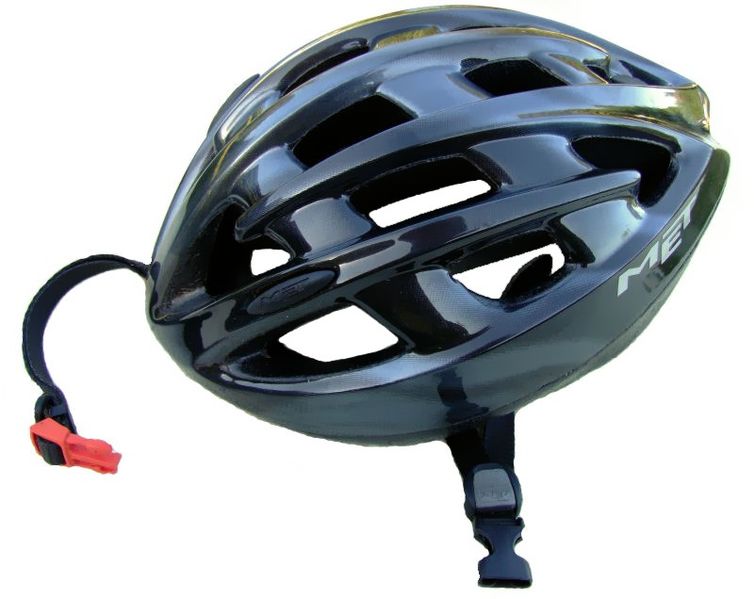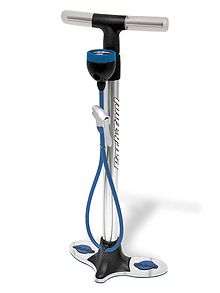I've been putting off any new posts. Although, I ironically had all summer with little to do, it was hard to bring myself to actually post anything. But I figure I might as well document the recovery process for those who might find themselves in a similar situation and wondering what to expect.
To clarify, if you are not yourself in the midst of healing from a similar injury, this post will be beyond boring. Please skip it! I'll post a picture of a fun bicycle or something tomorrow to make up for it!
6/5
Around five in the evening I fell off my bike in the woods. About an hour after I called 911, I was found and brought to the hospital. I was brought directly into the trauma ward of RI Hospital. I was given a healthy dose of drugs (which did little to help me) and a number of x-rays were taken. I remember telling the nurse that I was still in pain, and her telling me that I already had an exorbitant amount pain killers. When the doctor came in after looking at my x-rays he told the nurse to give me more pain killers. Apparently, it was a bad break!
Lying still didn't hurt, but what stands out was that transferring from one bed to another was excruciatingly painful. I was told that the surgery would be in the morning. I was caught off guard a bit as I felt it was awful and that I needed immediate surgery. After some reflection, I realized that surgeons need to sleep and live their lives, and so the next morning was a realistic "immediate". As I laid drugged (yet in pain), I lost track of time and eventually fell into an uneasy sleep.
6/6
If memory serves me correctly, I was expected surgery at 10, but there was some waiting to be brought down to surgery before it actually happened. Truth be told, my memory of my time in the hospital is a bit fuzzy, perhaps because of all the medication. Eventually, I was brought down to prep and the surgeon introduced himself and asked if I had any questions. I think I asked about when I'd get back on my bicycle, the same question I asked everybody. Most people, including the surgeon, told me "the fall", which of course is a very vague time when you're itching to ride. I don't remember much after this. Of course I was eventually gassed to sleep, and I awoke in the recovery room.
6/6-6/10ish
My time in the hospital is pretty fuzzy, but there are certain things I remember distinctly. For one, there wasn't enough room in the orthopedics wing, so I was kept in the neurological wing (which made for strange roommates who thought Teresa was a nurse and asked her to do things).
I don't know what I was expecting after the surgery, but the truth is that my left leg was completely straight and completely useless. It was strange. I couldn't bend it, move it, etc. The nurse's told me that some muscles had been cut through to repair the bone and that all the muscles in my leg had tightened up to protect my leg after the trauma. I didn't think much of it and spent a lot of time trying to mitigate the pain and watching marathons of Storage Wars and Pawn Stars on the tiny tv next to my bed.
I wasn't able to do much on my own. I couldn't get out of bed without help, and to walk I used a walker. I could put no weight on my left leg, which was good as it was essentially useless to me.
I was given the occasional "physical therapy", but it was so infrequent that it amounted to very little. I was given a walker to use, but its grips were so small that it pained my hands greatly to use it. Additionally, I could only use it with help, which was rarely available. In fact, I got the impression that the hospital staff was spread thin as a number of my calls for a nurse went unanswered and I was once even stuck half in my bed waiting for help, until I finally called again for help. This was an awful time of helplessness and pain. I felt depressed and really lamented my impending summer of nothingness.
One realization that I made while lying in bed one day was that I couldn't move my leg...at all. I don't know what it took me so long to figure it out, but it was completely useless. I don't exactly know how to describe the sensation, but when I tried to move my leg it would not respond at all. I was initially horrified. I had a moment of panic when it struck me that my nerves could have been severed mid-surgery. I decided that this has to be normal though and calmed myself down. Yet, one of my few distinct memories was of my realization that my leg was "dead" to me.
I was encouraged to sit up every day in a chair for a while, but it was incredibly difficult and painful when I finally got to the chair. I also fatigued easily both mentally and physically. Finally, there started to be talk of my discharge. I started to panic. I was told I'd be going to a rehab. I didn't feel prepared and things got worse when I heard I'd be going to a nursing home instead of an intensive program. Yes, apparently nursing homes have short term rehab programs. Where better to put a person with a broken hip anyways?
6/11ish-6/21ish
An ambulance transported me from the hospital back to a nursing home in Attleboro. It wasn't painless, but it certainly wasn't as bad as I'd feared. When I got there I once again felt panicked. It was a nursing home: pretty much exactly what you'd expect. The temperature was too warm, the people too old, and the cable too basic.
In reality, the nursing home was far more than that. As for my recovery, I started both physical therapy and occupational therapy. I was plagued by not knowing when I would have which, but I had them about three times a week or so. At OT I mostly showered. Thankfully, the nursing home had walk in showers and shower chairs. My OT was quite kind, but that was essentially what I did. For physical therapy, I did some small exercises (many for my arms as a wheelchair was my primary mode of transportation mixed with the walker that left my hands in pain or numb). I did do a number of exercises on my own, but they mostly consisted of flexing my ankles and pressing the back of my knee into the bed I was sitting on. These exercises are certainly not impressive to read about, but they required some effort on my part. I was quite excited when I was first able to actually move my leg in any way whatsoever, but truthfully, my leg was still quite useless. By the time I was leaving, I spent my PT time practicing up and down stairs on crutches as that was what I'd be doing when they released me to go home. One PT session was even devoted to the physical therapist coming to my house to do an evaluation where she gave suggestions for ways to rearrange the house to improve my accessibility and safety in the house as well practice going up and down the stairs.
By the time I left the nursing home I could competently use crutches, though there was one point where I almost passed out from over-exertion....which was really not all that much exertion. I didn't get many opportunities to move around in the nursing home as I wasn't allowed to walk on my own (with the crutches of course!). Throughout this time, I had what they called "toe touch weight bearing status". This essentially meant that I should put all of my weight on my good leg, and just a smidge on my bad leg to keep my balance. Of course my bad leg got weaker throughout this time as the bone healed.
6/21ish-7/12ish
When I got home I found things pretty difficult. The good news was that I wasn't experiencing much pain anymore. However, the stairs were challenging, sitting for long periods was difficult, and I was completely helpless. Of course, I couldn't carry anything while on crutches, so I couldn't feed myself. I couldn't shower without both a transfer bench and a little help. I couldn't get up and down the stairs alone, and I was stuck stationary most of the day. Once home I had a visiting nurse come to see me about once a week and a PT come to see me three times a week. The visiting nurse was actually rather superfluous at this point, but the PT had me do little exercises under her supervision/with her help. These were knee bends, stretches, and the likes. She also had me doing some exercises three times a day on my own. Strangely, straight leg lifts were impossible and seemed to be the most challenging leg movement to attempt.
7/10
I went to the doctor expecting my weight bearing status to be changed from "toe touch". My PT suspected he'd change me to 50% weight bearing or partial weight bearing "as tolerated". Like it sounds, this means that you can put as much weight on the leg as you can tolerate. When I saw the doctor he said that I could now be partial weight bearing. When I asked him how much that was, he essentially told me some of my weight. When I asked "So just put weight onto it and stop before it hurts?" he said "It is ok if it hurts a little". Eventually, when I went to the outpatient physical therapist he told me these two claims were contradictory. One said "partial" and the other described "as tolerated". He then contacted the surgeon for clarification. The surgeon told him "50 pounds". This was quite upsetting as it was a very small amount of weight and very surprising to my physical therapist.
7/16
This was my first day of outpatient physical therapy. It started with an intake, and then twice a week, I started to attend outpatient physical therapy. Here I was stretched, shown exercises to do at home, and led in exercises that I did there with their equipment. They were really kind and attentive and most of the exercises were gentle though strenuous. At this point I was still on two crutches and limited in what I could do.
8/9
I went to the surgeon this day expecting to be changed to full weight bearing and told to use a single crutch of cane. Once again, I was surprised. I was told I could put full weight on the leg, but I was told to continue using two crutches. I asked about riding my bicycle, and the surgeon said "No, you can't ride, what would you do with your crutches?" I felt stupid having asked, but only later stropped to consider that the surgeon had said no on the basis of not having anywhere to put the crutches on my bicycle. In truth, I didn't need my crutches on my bike. I wasn't going to commute by bicycle, I was going to ride a loop and finish where I began...where my crutches were. Nevertheless, I followed the doctor's orders as per usual.
8/13
I went to the PT and the physical therapist suggested I try to walk with a single crutch. In truth, I wasn't really using my second crutch much, but I didn't want to disobey the doctor. I tried and realized that the second crutch wasn't doing anything anyways, and I moved to a single crutch. My physical therapy became much more rigorous as I was not full weight bearing. Now I was doing exercises like balancing on my injured leg, squats, and other exercises that really did require full weight on my leg. I also started to go for short walks at home. At first I was easily exhausted by this, but I slowly got stronger.
I tried walking a bit without a crutch. It didn't really hurt, but my leg was too weak to support me, so I heavily limped. This amounted to my walking like Quasimodo or an orangutan.
8/21ish
I asked my physical therapist about bike riding. He told me that it didn't actually require full weight bearing status to ride (though mounting and dismounting obviously would), so he was very surprised the doctor told me not to. The next day I decided to ride my bike.
8/22-8/23
I started by riding my Specialized Hardrock mountain bike. The biggest struggle was mounting the bike. I put all my weight on my bad leg, and threw my good leg over the bike to get on. I helped balance myself by leaning on my garage while I did this. Then, to my surprise, I mounted my bike and started to ride. It was actually quite easy. I mean, my left leg was incredibly weak, but I didn't feel any pain, and I wasn't even skittish. I didn't record the ride the first day, but the second day I went about 4.5 miles. I also suspected I'd ache after the first ride, but I didn't feel anything. The second day, I started to feel sore though. My entire leg. In fact, the only part of my leg that wasn't sore was my hip. I did have an intense fear that I'd feel the device in my leg that they used to repair my leg. In the x-ray it looked horrible and like I'd definitely feel it. However, when I did finally ride, I felt nothing in my hip or thigh (other than tired muscles). Apparently, my leg happily accepted the device as part of my leg and the muscles healed around it good as new.
8/24-8/28
I had been a bit worried about riding a bike that I needed to clip into. I feared my leg would be too weak to rotate in the manner needed to disengage the pedal or that I'd be unable to unclip when I came to a stop. I decided I needed to up my game though, and I decided to take my Ridley XBow out. I stuck to the bike path in order to avoid any sudden need to disengage my pedal. When I first got on the bike I moaned a bit as I stretched out into the aggressive riding position and worked to lift my weak leg onto the pedal, but other than a loss of flexibility, I felt little to no pain or discomfort. I did a couple more 5 mile rides, and then a 9 miler, 11 miler, and a 12 miler. My biggest obstacle has been my loss of conditioning. At the end of each of these rides I am pretty exhausted. In fact the first couple were the most exhausted. I very quickly started to build up a tolerance to the effort with each day, and while I was continually sore, I felt great after each ride, and my leg became much stronger at a much quicker pace than it had been. I was even able to double the lengths of my walks without tiring.
This bring me to today. I really feel like these rides have kicked my recovery into full speed, even though I am constantly sore. It is strange not to be able to walk, but to be able to ride. I'm not sure what the next step in my recovery will be, but I feel confident that it will come soon.




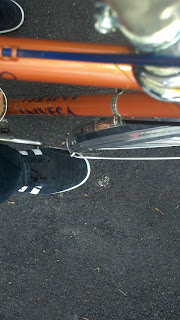

























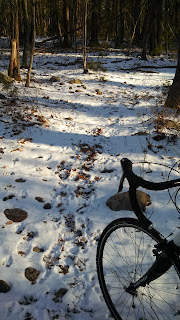

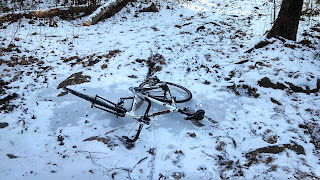





.jpg)



